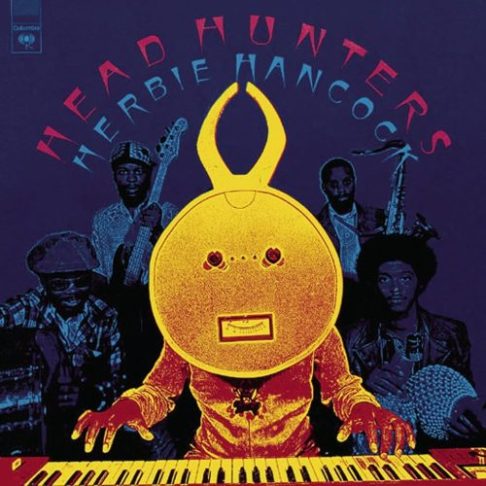Head Hunters, Herbie Hancock’s seminal jazz-funk album and the first jazz album to ever gain a platinum rating turned 51 years old this past Friday (10/26/24). Head Hunters was Hancock’s twelfth album as an artist and marked the first recording of Hancock’s new band (named the Head Hunters) after its formation in 1973. The album marked many important achievements for both Hancock himself (leader and pianist on the recording) and for jazz fusion as a genre.
The opening track, Chameleon, begins with an iconic bass riff that slowly develops into a dense and funky jam. Of the tracks on Head Hunters, it is the most prevailing and has found a place in the canon of jazz standards (songs that jazz musicians generally know and play). The almost sixteen-minute-long track develops slowly, first adding instrument after instrument into the fray before launching into the main saxophone riff that marks the space between length solos. The first solo on the track (Herbie Hancock on an early synthesizer (specifically the ARP Odyssey) sees the musician combining traditional jazz soloing with the new sounds of a synth, utilizing the new sound as an interesting piece of a sonic palette that brings to mind both the sound of classic funk and a new, spacier sound. The solo at times sounds alien and in others is firmly rooted in the jazz tradition. This tonal contrast helps keep the track interesting as the saxophone riff returns and the next solos cycle through an entirely different B-section where the chord changes grow more complex and fit into the traditional jazz canon more smoothly. The contrast between these sounds lends itself as a microcosm of the album’s sound itself. I think that this track is the most powerful on the album for it’s fusion of new and old sounds. The track is densely layered enough to encourage repeated listens and is so fresh all these years later. The track’s prevalence among jazz musicians of later generations I believe boils down to the powerful and catchy bassline which lends this track the strongest and most cohesive sound on the album.
The second (and last) song on the A-Side is titled Watermelon Man. Watermelon Man is the only track on the album that had been recorded prior to the 1973 session, as the track was first written for Hancock’s 1962 album Takin’ Off, where the track was recorded in Hancock’s earlier jazz style. Eleven years after the original recording, Hancock re-recorded the track with a completely different take, reinterpreting the hard-bop original into a much funkier version. This version begins with an iconic (and quite ear-catching) introductory piece that consists of Bill Summers (the percussionist on the album) blowing into beer bottles in an effort to imitate hindewhu, a form of Pygmy music found in Central Africa. )
After the introduction, the band locks into a groove heavily inspired by funk of the time, with synthesizers slowly joining an opening bass/drum funk groove. The composition of the track mirrors that of chameleon in that both introduce the disparate instruments slowly, adding to an overall groove. Once the groove is established, the band locks into the familiar melody from the 1963 recording, except the main melody is now played by Hancock on a synthesizer. The groove builds into a stop-start function section before beginning all over again (though the melody is now played on the saxophone). Unlike Chameleon, there are no solos on Watermelon Man, with the track instead repeating the melody over a static groove for most of its runtime. This relatively straight interpretation of the track reflects much of the funk influence on the album, allowing the song to build in intensity without the need for soloists to lead the charge. The groove of the song is joined by the introductory piece once again and the song begins to fade ending the A side of Head Hunters. I think that this track’s clear African influence betrays an interesting other kind of fusion than that of the jazz and funk fusion. This fusion of an American tradition (though with African roots) with traditional pygmy music lends the track a unique sound. The sound of the song, I think, is a wonderful blend of sounds which is a magnificent foil to the sounds of Chameleon.
I believe that the album’s influence on music after it cannot be overstated, and its four songs have been covered countless times. The most enduring track on the record, Chameleon has been recorded by artists from Buddy Rich (famous jazz drummer) to Umphrey’s McGee (a modern rock band). The album, apart from its far-reaching influence, largely revitalized Hancock’s career, shifting the trajectory from a descent into obscurity in the early seventies, to the first jazz artist to ever have an album go platinum. After the release of the album, Hancock retained a successful career until the present day, as well as still continuing to tour in modernity.
Musicians List:
- Herbie Hancock – Fender Rhodes electric piano, Hohner D6 Clavinet, ARP Odyssey & ARP Pro Soloist synthesizers
- Bennie Maupin – tenor saxophone, soprano saxophone, saxello, bass clarinet, alto flute
- Paul Jackson – bass guitar, marímbula
- Harvey Mason – drums, arrangement on “Watermelon Man”
- Bill Summers – agogô, balafon, cabasa, congas, gankogui, log drum, shekere, surdo, tambourine, beer bottle on “Watermelon Man”


